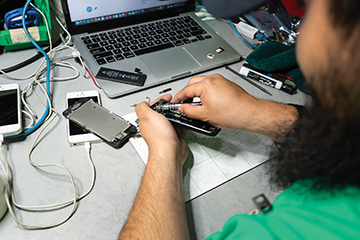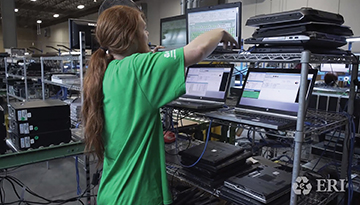Electronic Recycling and Reuse: Reviewing the Trends as We Look to the Future
By John Shegerian & Kevin Dillon, ERI
The consumer electronics landscape continues to evolve and shift. Issues such as manufacturer compliance, effective data destruction and data protection have become top of mind concerns for recycling customers and are now essential elements of the responsible electronic recycling or reuse process.
For recyclers in the industry unwilling to address these issues, it’s been a struggle. But for those embracing change as opportunity, it’s clear that with the current trends in electronic recycling pose great promise for the industry as a whole.
Regardless of regulatory changes, shifting trends in reuse and refurbishment, or the increasing need for appropriate management of data, one thing that remains a constant is the steady growth of electronic devices that are discarded by businesses and consumers each year.
Cell phones are typically replaced every 18 months or less, whereas desktop computers last the average consumer about two years. TVs last much longer—about 10 years—but DVD players are usually discarded after only two years!
Based on this information, it’s not surprising that in the U.S. alone, more than 100 million cell phones are thrown away every year. The U.S. also gets rid of 20 million TVs and 41.1 million computers every year. Overall, the average family spends about $1,400 every year on electronic devices. As this trend continues, the e-waste stream will continue to grow.
According to the EPA, e-waste continues to be the fastest growing waste category in the municipal waste stream. Even though other types of waste are decreasing, the amount of e-waste that is collected is rising by about 5% every year.
With the current movement of the IT industry toward cloud computing and the increased reliance on tablets and mobile devices in the workplace and in schools, it is likely that refurbishment will also continue to spike for the long term. Refurbishing computers and laptops and even mobile phones will continue to increase as these devices enter the e-waste stream in large volumes and countries around the world continue to require proper disposal.

Well-Rounded ITAD Companies are Here to Stay
The biggest trend we’re faced with as an industry is the increasing focus on comprehensive IT Asset Disposition (or ITAD). Whether a device is being broken down for recycling, refurbished or reused, the primary goal of the ITAD process is to keep the data on these devices secure at all times during the disposal process – while protecting the environment from the harmful effects of e-waste.
Customers are becoming more attuned to the fact that they want to engage with ITAD companies that dispose of electronic devices in special facilities that are designed solely for this purpose.
If the device can be reused, it will not be destroyed. Instead, the ITAD company will destroy the data on it and sell the wiped device. It’s become understood that the good ITAD companies use data destruction methods that are far more effective than what the average consumer is capable of using. Destroying data involves much more than simply overwriting the data—today, ITAD vendors destroy data in accordance with the Department of Defense and NIST Guidelines for Media Sanitization standards.
There are other reasons why more and more businesses are seeking out the services of reliable ITAD vendors. For starters, cybersecurity threats should be on the mind of every business owner in the country. Every business—regardless of the business’s size or the industry it is in—should be concerned about the possibility of hackers accessing their confidential data. ITAD vendors completely destroy the data stored on devices prior to disposing of them. This is the only way to ensure that a client’s information—and their customers’ information—is protected.
Of course, ITAD companies also keep hazardous materials out of landfills. But using an ITAD vendor is not only the right thing to do for the environment. It is also a way for many businesses to save money by avoiding fines. Businesses may even be able to make some side revenue by working with an ITAD vendor that shares the profits made after reselling components of the electronic devices.
Businesses within certain industries, such as those involved in healthcare or finance, now have a legal obligation to properly destroy data when getting rid of old electronic devices. For instance, every business in the healthcare industry must comply with the Health Insurance Portability and Accountability Act (HIPAA) when it comes to data destruction. To comply with HIPAA, businesses must implement effective policies and procedures that address how data will be protected during the disposal of IT assets. Many healthcare businesses turn to reputable ITAD vendors to ensure they are compliant with this law.

The Keys to a Successful Future in Recycling and Refurbishing Electronics
So for the players in the recycling or electronics recycling and reuse industries, what are the keys to success moving forward? Here’s a checklist of some of the primary factors and ingredients for success as we move toward 2020:
Be Part of the Circular Economy
With global consumer spending expected to double by 2030, there is an urgent need to secure resources as well as develop new production models that fit within planetary constraints, especially with electronic devices, the fastest growing sector of the waste stream today. Now is the time to partner with customers to jointly trailblaze the Circular Economy by closing the materials loop. If done right, all metals, plastics, glass…everything…can be tracked and prepared for beneficial re-use into new products. Plus, facilities should always be 100% zero waste, zero landfill.
Help Your Customers Understand the Importance of Data Breaches
Some companies are ignoring the problem altogether, but others are making a genuine effort to prevent data breaches. However, the companies that are investing in cybersecurity are still being targeted by hackers. Even though cybersecurity awareness is growing, this won’t prevent future attacks unless decision makers are willing to listen to IT experts and implement their recommendations. Become certified by the National Association for Information Destruction (NAID) and let your current and future customers aware of the safety net you are providing them with.
Manage the Details to Maximize Refurbishment and Reuse Options
Employ dedicated staff of carefully qualified employees who specialize in complete asset refurbishment and resale, including the provision of testing and auditing services to determine the usefulness of each item and to capture important tracking information from each major component. Also, due to the sensitive information contained in almost all electronic memory components, make sure to follow a stringent data management process to ensure that sensitive data is not inadvertently compromised.
Process Effectively
In order to maintain your customers’ confidence as well as your bottom line, it is important to have your executive team regularly assessing and auditing your operations so as to process efficiently and reduce costs. The sustainability of your organization will be based upon your company’s ability to increase revenue and reduce costs.
Keep Innovating Technology
Long ago, ERI made a commitment to innovative technology, and we believe that’s one of the main reasons we’ve been able to stay ahead of the game. But you don’t have to have the world’s largest and most sophisticated shredders, like ERI does, to be successful. In an industry driven by and focused on technology, providing innovative solutions is a must.
Provide Nationwide Solutions
The big customers that help sustain us in this industry are rarely limited to one state’s borders. Offer a multi-facility, certified, nationwide ITAD solution – and if that’s beyond your capacity, partner with organizations that can.
Establish a Global Network of Partners
As the world gets smaller, don’t limit your capabilities to the US. Build effective partnerships that broaden your scope on a global level. Companies are looking at single providers globally to manage their ITAD needs. So there is a distinct trend among customers to reduce the number of ITAD/e-Waste suppliers they may currently be using.
Invest in a High-End Commodity Process
If your commodity extraction process is running at maximum efficiency, the cleanliness of your final commodities will enable you to pass cost-savings along to customers from an EOL perspective. Communicate with Manufacturers As technology evolves, gets smaller, and changes so dramatically from year to year, it is essential to maintain a consistent dialog with manufacturers to make sure you understand the new products that are coming and how they will need to be processed at their ends of life.
Be Diverse
For success in 2020, it’s going to be essential to offer a comprehensive suite of services to your customers. It is rarely enough today to be a recycler of electronics. Providing that, plus data security and the ability to meet and consult upon environmental and data security regulatory issues (be they state or federal regulatory concerns) is key.
Supply Chain Management
The organizations that make up a supply chain are linked together through physical flows and information flows. The world of electronic recycling is no exception. This goes back to a high level of interface and communication, both with your customers to determine their needs, and with the manufacturers, to stay abreast of what has and will be entering the supply chain.
Always do the Right Thing
We understand as well as anyone that the fluctuating commodity prices and other issues pose fiscal challenges to our industry, but it is essential to remain ethical and always do the responsible thing, even if it delivers a ding to the bottom line. Shipping materials to be processed overseas, for example, is a shortcut not worth taking. We see too many in our industry resorting to this, and when they get caught the consequences can be devastating. So doing the right thing, even at the expense of temporarily challenging the bottom line, will ultimately be rewarded with a healthier bottom line in the long run – and will engender longer term trust and loyalty among your customer base.
 John Shegerian & Kevin Dillon
John Shegerian & Kevin DillonERI’s co-founder and Executive Chairman John Shegerian and ERI’s Chief Marketing and Sales Officer and co-founder, Kevin J. Dillon, together have played a significant role in paving the way for the electronic recycling and ITAD industries as a whole. Building ERI from the ground up, Shegerian and Dillon have constructed a new gold standard. Today, ERI is the nation’s largest fully integrated IT and electronics asset disposition provider and cybersecurity-focused hardware destruction company in the United States. ERI is certified at the highest level by all leading environmental and data security oversight organizations to de-manufacture, recycle, and refurbish every type of electronic device in an environmentally responsible manner. ERI has the capacity to process more than a billion pounds of electronic waste annually at its eight certified locations, serving every zip code in the United States. Under Shegerian’s and Dillon’s stewardship, ERI’s mission is to protect organizations, people and the environment.